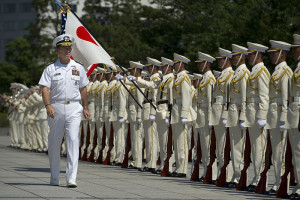An Evolving Japanese Self-Defense Force
On July 1, 2014, Japan’s Cabinet under Shinzo Abe administration approved a document that revised the interpretation of the Constitution regarding Japan’s security policies. The Constitution has long been recognized as a symbol of Japan’s pacifism after its substantial involvement in World War II and the subsequent devastating defeat. The present reformation of the Japanese Constitution that seeks to expand the role of Japan’s Self Defense Force reflects Prime Minister Shinzo Abe’s pursuit of active pacifism. On May 3rd, 1947, Douglas MacArthur, the Supreme Commander of the Allied Powers, oversaw the rewriting of the Japanese Constitution in order to ensure the application of three distinctive features: the symbolic role of the Emperor, the prominence of guarantees of civil and human rights, and the renunciation of war. Of the three features listed, the renunciation of war is the most relevant element to the current debate. Article 9 of the Constitution, which disallows maintenance of a standing military force, most directly assures the fulfillment of this feature. The original interpretation of Article 9 led to the establishment of the Self Defense Force, in order to maintain the Japan’s right to self-defense.

Although originally formed as an extension of the national police force, current estimates place the military capabilities of the Self Defense Force--especially its naval division--above that of many neighboring countries. Japan’s current international engagements include cooperation in UN Peacekeeping Operations in South Sudan and the protection of the coastline of Somalia as well as the Gulf of Aden. The Self Defense Force has also been actively engaged in providing disaster relief both at home and abroad, especially following the Great East Japan Earthquake that struck northern Japan in 2011. In addition, the Self Defense Force was mobilized in the Iraq War of 2003 as support for the United States, citing earlier aggression against Japan as basis for the use of force in this specific situation. This, and several other cases in which the Self Defense Force has engaged in international conflict, have largely been justified by policy makers through the exploitation of loopholes in the wording of Article 9.
Reinterpretation of Article 9 under the Abe administration, suggested as a way of further expanding the role of the Self Defense Force, is criticized as a desire to return Japan to militarism. Such a reinterpretation would allow the Self Defense Force to respond to international conflicts under the guise of collective self-defense. Following the Cabinet’s approval on July 1st, 2014, Prime Minister Abe’s optimistic statement was reported by Asahi Shinbun: “the risk that Japan will be involved in a war will be reduced further.” Despite many concerns from the public about increased chances of engaging in wars, Prime Minister Abe further explained that, “what the Constitution allows for are only self-defense measures to maintain the existence of our country and protect our people. We will not use force for the sole purpose of defending a foreign country.”
Although Prime Minister Abe called it a “misconception,” the Self Defense Force’s commitment to collective self-defense faced profound public criticism. On June 30th, the day before the Cabinet’s approval of the initiative, a man set himself on fire in the middle of Shinjuku, an especially crowded district in Tokyo. While attracting attention from onlookers, the man denounced Prime Minister Abe’s desire to legally appropriate collective self-defense as a means of expanding the mandate of the Self Defense Force. Prior to the announcement of Cabinet’s decision, protesters gathered in many parts of Japan and lobbied against the announced reinterpretation of Article 9. A mother of two sons from the Kanagawa prefecture suggested the collective of Japanese citizens abiding by the peaceful nature of Article 9 as a candidate for the Nobel Peace Prize of 2014. More than 20,000 supporters joined her effort in criticism of the Constitutional reform, showing strong public opinion against the reduction of military restrictions.
Despite a lack of support from the Japanese public, a revised set of security bills were delivered on Wednesday, March 18th, 2015. Approved by the Liberal Democratic Party and its coalition party, the Komeito, the new bills set out a framework that expands the scope of the Self Defense Force’s future military engagements. Initially suggested by the Komeito following the Cabinet’s approval last year, the framework includes new conditions that must be met before the collective self-defense right is allowed: “Armed attacks occur on other countries with which Japan has a close relationship and threaten the existence of our country as the people’s rights to life; liberty and the pursuit of happiness face the apparent danger of being fundamentally overturned.” The revision enables future administrations to dispatch the Self Defense Force on collective security operations sanctioned by the US Security Council for military action against an invading nation. It also expands the role of the Self Defense Force to include protecting warships and other U.S. military materials employed to defend Japan, and to expand the range of ship inspections beyond Japanese waters.
The Diet deliberations are scheduled to take place Friday, March 20th, 2015 to determine its formal approval after internal discussions by each party. The government will be writing the texts of the bills in April.
After the shocking beheadings of two Japanese hostages by the ISIS at the beginning of the year, the Japanese public has become suddenly aware of their increased vulnerability to ISIS threats. The passage of these bills would be a turning point in shaping future security policies and would mark a huge increase in Japan’s international presence.
However, a stronger international image could hinder cooperation with Japan’s neighboring countries in East Asia. Japan risks especially upsetting North Korea and China with its alliance with the US. The return to militarism could also recall sentiments and reignite historical tensions with countries such as South Korea and China. Whether Prime Minister Abe’s emphasis on active pacifism to confront threats towards Japan’s western allies without sacrificing regional security remains a key question in the region.
